Bureau Veritas Bundle
How Did a Maritime Insurance Bureau Become a Global Inspection Powerhouse?
Ever wondered how a company could revolutionize global trade through meticulous inspection and certification? Bureau Veritas (BV company), a leading French company, started its journey in 1828, aiming to reduce risks in maritime insurance. This Bureau Veritas SWOT Analysis reveals the strategic insights behind its remarkable transformation from a specialized bureau to a global leader in Testing, Inspection, and Certification (TIC) services.
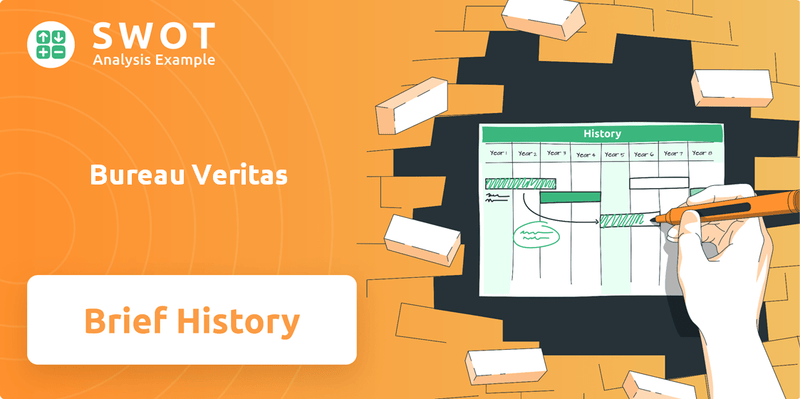
From its origin story in Antwerp, Belgium, Bureau Veritas history is a testament to its adaptability and commitment to quality control. Today, it operates in 140 countries, offering comprehensive certification services across diverse sectors. Understanding the brief history of Bureau Veritas provides critical context for appreciating its enduring impact on global supply chains and its role in ensuring safety and sustainability.
What is the Bureau Veritas Founding Story?
The story of Bureau Veritas (BV company) began in 1828. It was founded in Antwerp, Belgium, and has grown into a global leader in testing, inspection, and certification services. This French company has a rich history.
The founding of Bureau Veritas is a tale of vision and foresight. It was a response to the challenges of early 19th-century maritime trade. The founders aimed to bring reliability to a high-risk industry.
The official founding date of Bureau Veritas was May 19, 1828. Alexandre Delehaye and Louis van den Broek were the key figures. Delehaye, with his naval background, understood ships. Van den Broek, a businessman, saw the potential in providing information to the maritime insurance market.
The initial focus was on assessing ships. The goal was to give insurers a clear view of risks. The company's first offering was a classification system for vessels.
- Surveyors inspected ships.
- Detailed reports were created.
- Insurers quickly adopted the service.
- It helped reduce financial risks.
The early business model was innovative. It provided objective assessments of ships and equipment. This helped insurers make informed decisions. The founders likely used their own capital to start the business.
The timing was perfect. Global trade was expanding. Sea travel was inherently dangerous. Bureau Veritas offered a solution. It brought order and predictability to the maritime industry. Today, Bureau Veritas is a major player in the inspection company sector.
For a look at how it stacks up against its rivals, check out the Competitors Landscape of Bureau Veritas.
Bureau Veritas SWOT Analysis
- Complete SWOT Breakdown
- Fully Customizable
- Editable in Excel & Word
- Professional Formatting
- Investor-Ready Format
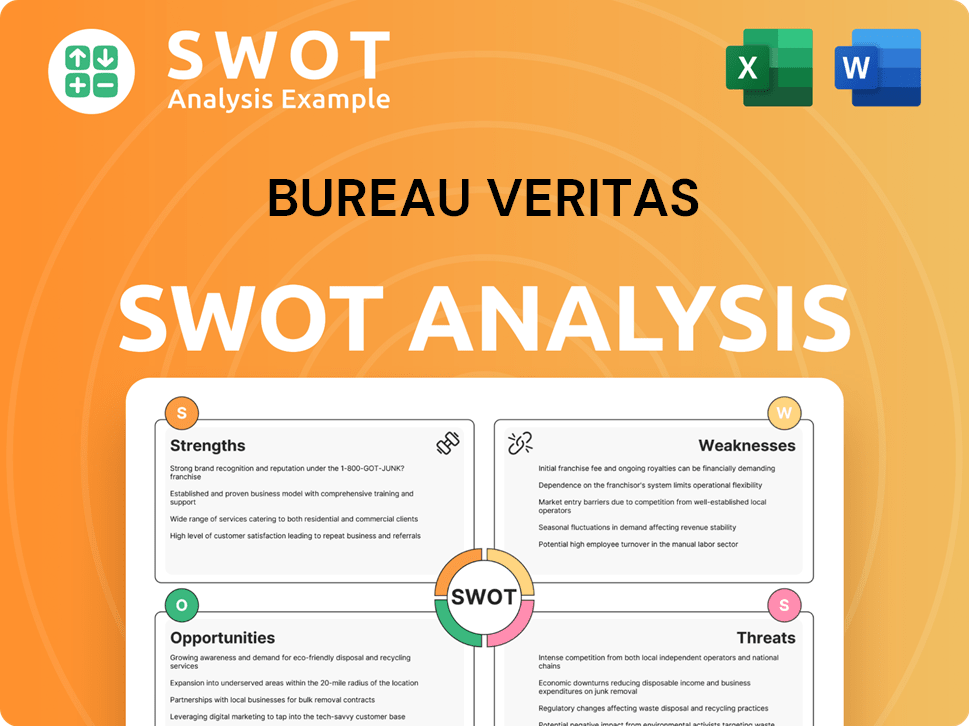
What Drove the Early Growth of Bureau Veritas?
The early growth of Bureau Veritas, or BV company, was closely tied to the expansion of global maritime trade. Founded in Antwerp, the inspection company quickly established its first foreign branch in Paris in 1829. This expansion marked the beginning of its journey to becoming a global leader in testing, inspection, and certification services.
Following its establishment, Bureau Veritas rapidly expanded its footprint. The opening of the Paris branch in 1829 was a pivotal move, followed by the launch of its first register of ships in 1830. This register provided unprecedented transparency in the industry. The company's early focus on maritime services set the stage for its future diversification.
As the Industrial Revolution gained momentum, Bureau Veritas expanded its services beyond the maritime sector. By the late 19th century, the French company was inspecting railway equipment, industrial machinery, and public buildings. This diversification demonstrated the company's adaptability and foresight in recognizing the need for quality and safety across various industries.
The growth of Bureau Veritas during this period involved the recruitment of skilled engineers and inspectors. While major capital raises were not common, the company's expansion was funded through retained earnings and increasing fees. Leadership transitions also played a role in professionalizing management as the company scaled its operations. Read more about the Marketing Strategy of Bureau Veritas.
The market's reception to Bureau Veritas's services was overwhelmingly positive. The company provided much-needed trust and standardization in rapidly industrializing economies. This early diversification and commitment to expanding its expertise laid the groundwork for Bureau Veritas's future as a multi-sector TIC leader. This established the company's core values.
Bureau Veritas PESTLE Analysis
- Covers All 6 PESTLE Categories
- No Research Needed – Save Hours of Work
- Built by Experts, Trusted by Consultants
- Instant Download, Ready to Use
- 100% Editable, Fully Customizable
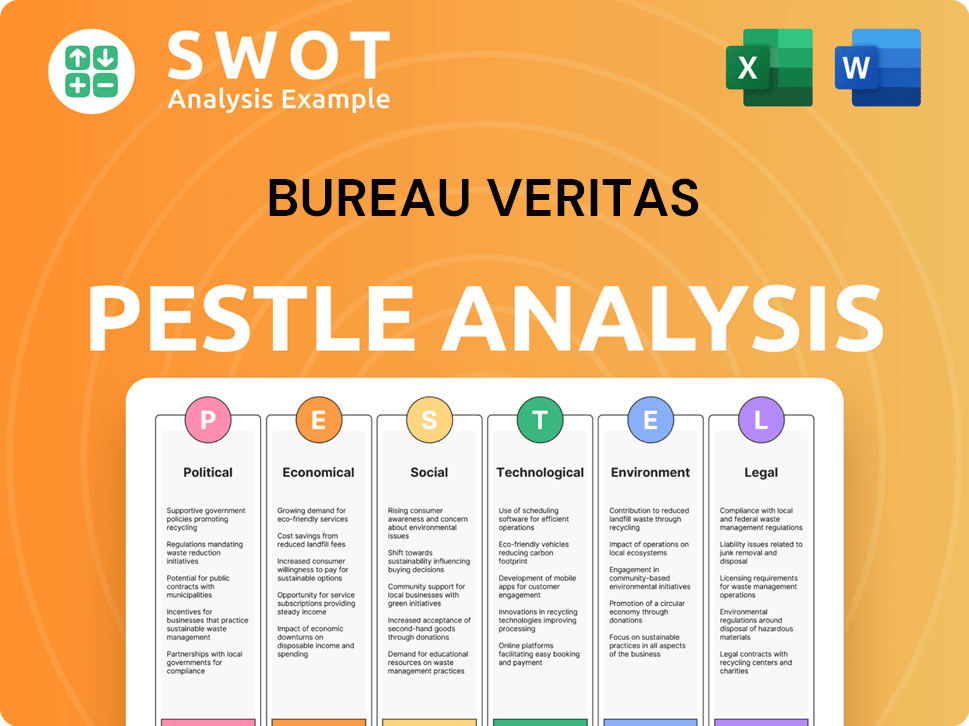
What are the key Milestones in Bureau Veritas history?
The history of BV company is marked by significant milestones that have shaped the Testing, Inspection, and Certification (TIC) industry. From its inception, the French company has consistently adapted to meet the evolving needs of its clients and the global market. This adaptability has been crucial to its longevity and success.
| Year | Milestone |
|---|---|
| 1828 | Founded in Antwerp, Belgium, as the Bureau de renseignements pour les assurances maritimes (Information Office for Maritime Insurance). |
| Late 19th Century | Developed the first rules for the classification of steel ships, ensuring the safety of increasingly complex vessels. |
| Early 20th Century | Pioneered the inspection of aircraft, demonstrating foresight in adapting to new technological advancements. |
| Throughout the 20th Century | Expanded its services to include various industries, establishing a global presence. |
| 21st Century | Focused on sustainability services, recognizing the growing importance of environmental and social responsibility. |
Bureau Veritas history includes a series of innovations that have driven its growth and relevance. The company's early adoption of new technologies and its commitment to setting industry standards have been key to its success. These innovations have allowed Bureau Veritas to stay ahead in a competitive market.
Developed the first rules for classifying steel ships, a groundbreaking innovation that significantly improved maritime safety. This initiative set a new standard for the industry.
Pioneered aircraft inspection, demonstrating an early understanding of the importance of safety in the aviation sector. This foresight helped the company expand its service offerings.
Collaborated with international standardization bodies to shape global industry norms. This helped Bureau Veritas establish itself as a leader in setting quality standards.
Received accreditations from various national and international authorities, validating its expertise and impartiality. These accreditations are crucial for maintaining trust.
Developed new offerings in areas like carbon footprint verification and supply chain traceability. This shift reflects the growing importance of environmental responsibility.
Invested heavily in digital tools and platforms to enhance service delivery and client experience. This includes online portals and data analytics for improved efficiency.
Bureau Veritas has faced numerous challenges throughout its history, requiring it to adapt and evolve. Market fluctuations, competitive pressures, and the need to meet changing regulatory requirements have tested the company's resilience. The ability to overcome these obstacles has been critical to its continued growth.
Economic crises have impacted demand for services, requiring strategic adjustments. The company has navigated these challenges through diversification and cost management.
Competition from other Inspection company players has necessitated continuous innovation and service diversification. This has driven Bureau Veritas to enhance its offerings.
Evolving regulatory landscapes have required constant adaptation and investment in compliance. This includes staying current with international standards.
Managing a rapidly expanding global workforce has presented challenges in terms of standardization and training. Ensuring consistent service quality across diverse regions is crucial.
Standardizing inspection protocols across diverse cultures and legal frameworks has required significant investment in training and technology. This ensures consistent service delivery.
The increasing focus on sustainability has required Bureau Veritas to develop new services and adapt its business model. This includes expanding its offerings in environmental and social responsibility.
Bureau Veritas Business Model Canvas
- Complete 9-Block Business Model Canvas
- Effortlessly Communicate Your Business Strategy
- Investor-Ready BMC Format
- 100% Editable and Customizable
- Clear and Structured Layout
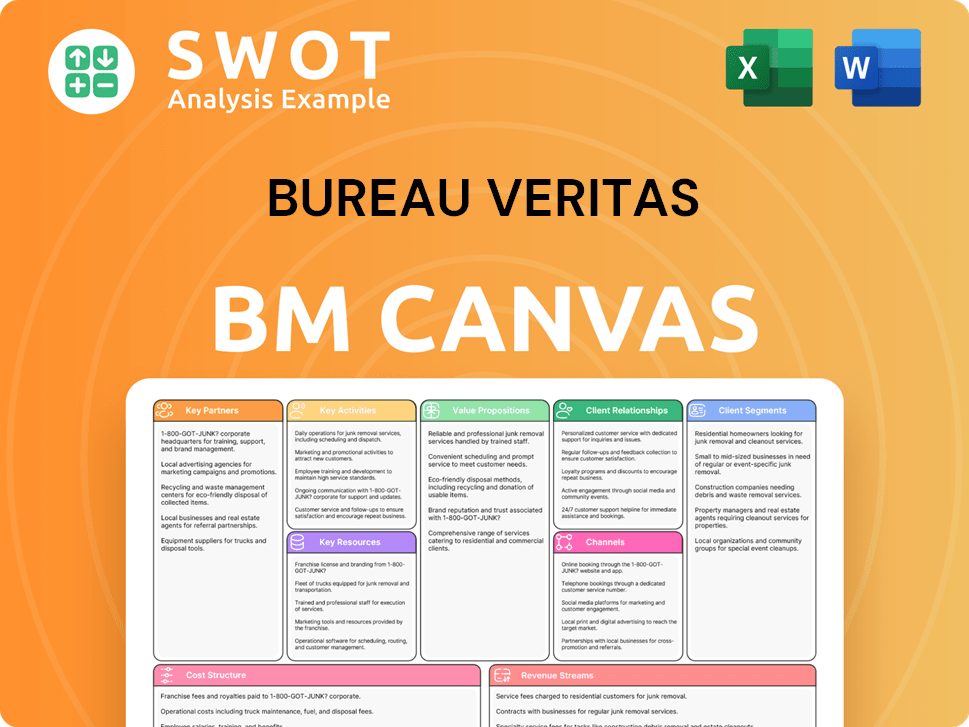
What is the Timeline of Key Events for Bureau Veritas?
The BV company, a leading inspection and certification services provider, has a rich history marked by significant milestones. Founded in 1828 in Antwerp as Bureau de Renseignements pour les Assurances Maritimes, it quickly expanded to Paris in 1829, establishing its first foreign branch. Throughout the late 19th and early 20th centuries, it broadened its scope to include industrial inspection and aviation, and by the mid-20th century, it had achieved global expansion. The 1980s saw diversification into new sectors, followed by a focus on environmental protection and quality management in the 1990s. The company went public in 2007 and has since emphasized sustainability, digital transformation, and smart services, reporting €5.7 billion in revenue in 2023.
| Year | Key Event |
|---|---|
| 1828 | Founding of Bureau de Renseignements pour les Assurances Maritimes in Antwerp. |
| 1829 | First foreign branch established in Paris, France. |
| 1830 | Publication of the first Register of Shipping. |
| Late 19th Century | Expansion into industrial inspection and the development of rules for steel ships. |
| Early 20th Century | Pioneering inspections in the aviation sector. |
| 1950s-1970s | Significant global expansion, establishing offices across continents. |
| 1980s | Diversification into new sectors including construction and consumer products. |
| 1990s | Focus on environmental protection and quality management systems. |
| 2007 | Initial Public Offering (IPO) on Euronext Paris. |
| 2010s | Increased emphasis on sustainability, digital transformation, and smart services. |
| 2023 | Bureau Veritas reports revenue of €5.7 billion, with 2023 organic growth at +6.3% and adjusted operating margin at 15.6%. |
| 2024 | Continued strategic acquisitions to strengthen market position in key growth areas like renewable energy and cybersecurity. |
The company is actively integrating AI and data analytics to enhance its inspection and certification processes. This includes the development of digital platforms to improve efficiency and provide clients with more insightful solutions. These efforts are aimed at streamlining operations and improving the customer experience.
The company is expanding its services related to climate change adaptation, the circular economy, and ethical supply chains. It aims to support clients in achieving their sustainability goals, aligning with global trends toward net-zero emissions and greater corporate responsibility.
The company is focused on strengthening its presence in high-growth markets, particularly in renewable energy and cybersecurity, through strategic acquisitions. These moves are designed to capitalize on the increasing demand for inspection and certification services in these sectors.
The Inspection company is poised to benefit from industry trends such as increasing regulatory complexity and the demand for greater transparency. The global push towards net-zero emissions and sustainable practices presents both opportunities and challenges for the company's future growth.
Bureau Veritas Porter's Five Forces Analysis
- Covers All 5 Competitive Forces in Detail
- Structured for Consultants, Students, and Founders
- 100% Editable in Microsoft Word & Excel
- Instant Digital Download – Use Immediately
- Compatible with Mac & PC – Fully Unlocked
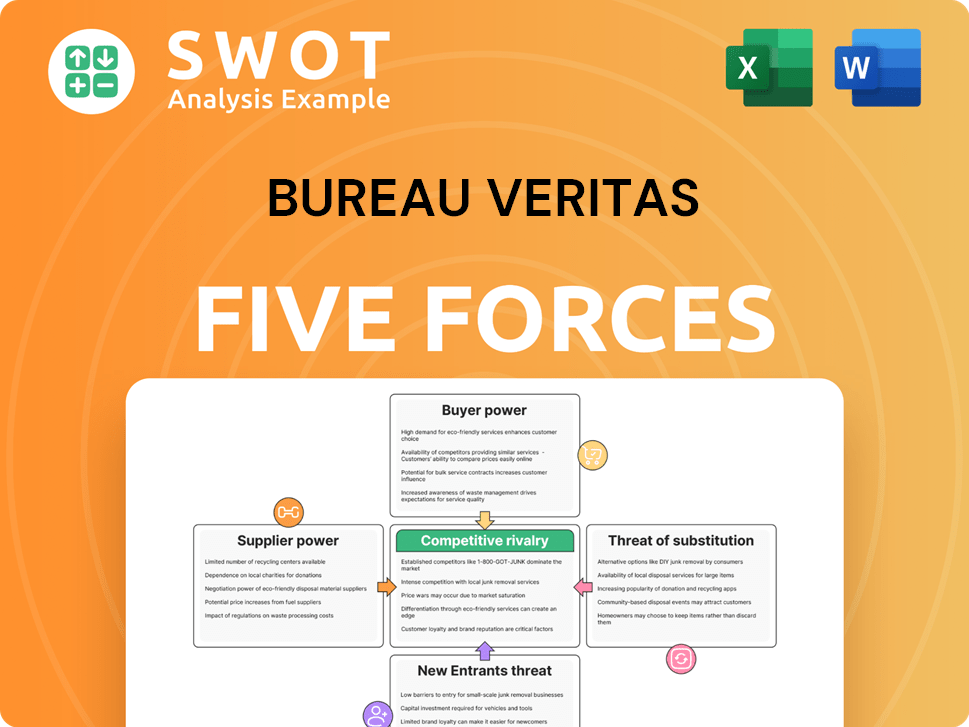
Related Blogs
- What is Competitive Landscape of Bureau Veritas Company?
- What is Growth Strategy and Future Prospects of Bureau Veritas Company?
- How Does Bureau Veritas Company Work?
- What is Sales and Marketing Strategy of Bureau Veritas Company?
- What is Brief History of Bureau Veritas Company?
- Who Owns Bureau Veritas Company?
- What is Customer Demographics and Target Market of Bureau Veritas Company?
Disclaimer
All information, articles, and product details provided on this website are for general informational and educational purposes only. We do not claim any ownership over, nor do we intend to infringe upon, any trademarks, copyrights, logos, brand names, or other intellectual property mentioned or depicted on this site. Such intellectual property remains the property of its respective owners, and any references here are made solely for identification or informational purposes, without implying any affiliation, endorsement, or partnership.
We make no representations or warranties, express or implied, regarding the accuracy, completeness, or suitability of any content or products presented. Nothing on this website should be construed as legal, tax, investment, financial, medical, or other professional advice. In addition, no part of this site—including articles or product references—constitutes a solicitation, recommendation, endorsement, advertisement, or offer to buy or sell any securities, franchises, or other financial instruments, particularly in jurisdictions where such activity would be unlawful.
All content is of a general nature and may not address the specific circumstances of any individual or entity. It is not a substitute for professional advice or services. Any actions you take based on the information provided here are strictly at your own risk. You accept full responsibility for any decisions or outcomes arising from your use of this website and agree to release us from any liability in connection with your use of, or reliance upon, the content or products found herein.